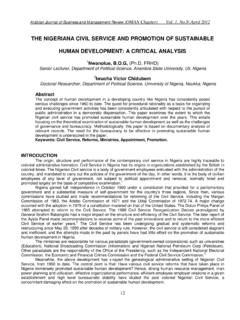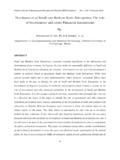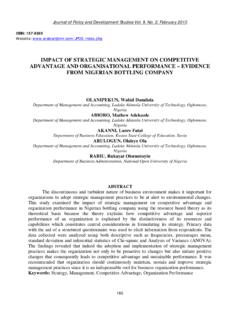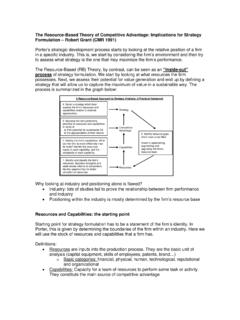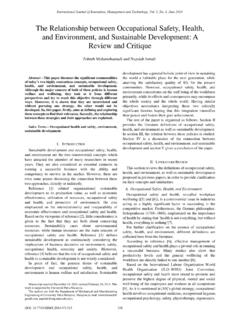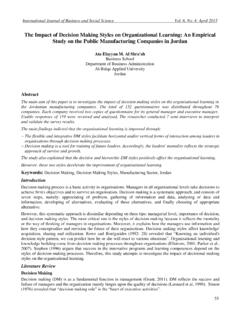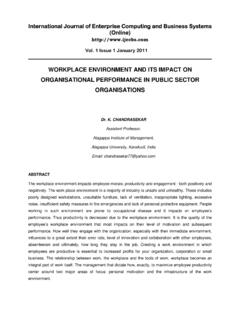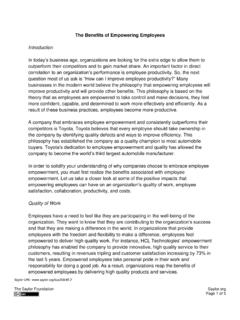Transcription of IMPACT OF STRATEGIC MANAGEMENT ON COMPETITIVE …
1 Journal of Policy and Development Studies Vol. 9, No. 2, February 2015 ISSN: 157-9385 Website: 185 IMPACT OF STRATEGIC MANAGEMENT ON COMPETITIVE ADVANTAGE AND ORGANISATIONAL PERFORMANCE EVIDENCE FROM NIGERIAN BOTTLING COMPANY OLANIPEKUN, Wahid Damilola Department of MANAGEMENT and Accounting, Ladoke Akintola University of Technology, Ogbomoso, Nigeria ABIORO, Mathew Adekunle Department of MANAGEMENT and Accounting, Ladoke Akintola University of Technology, Ogbomoso, Nigeria AKANNI, Lanre Fatai Department of Business Education, Kwara State College of Education, Ilorin ARULOGUN, Olaleye Ola Department of MANAGEMENT and Accounting, Ladoke Akintola University of Technology, Ogbomoso, Nigeria RABIU, Rukayat Oloruntoyin Department of Business Administration, National Open University of Nigeria ABSTRACT The discontinuous and turbulent nature of business environment makes it important for organizations to adopt STRATEGIC MANAGEMENT practices to be at alert to environmental changes.
2 This study examined the IMPACT of STRATEGIC MANAGEMENT on COMPETITIVE advantage and organization performance in Nigerian bottling company using the resource based theory as its theoretical basis because the theory explains how COMPETITIVE advantage and superior performance of an organization is explained by the distinctiveness of its resources and capabilities which constitutes central considerations in formulating its strategy. Primary data with the aid of a structured questionnaire was used to elicit information from respondents. The data collected were analyzed using both descriptive such as frequencies, percentages mean, standard deviation and inferential statistics of Chi-square and Analysis of Variance (ANOVA). The findings revealed that indeed the adoption and implementation of STRATEGIC MANAGEMENT practices makes the organization not only to be proactive to changes but also initiate positive changes that consequently leads to COMPETITIVE advantage and sustainable performance.
3 It was recommended that organization should continuously maintain, sustain and improve STRATEGIC MANAGEMENT practices since it is an indispensable tool for business organization performance. Keywords: Strategy, MANAGEMENT , COMPETITIVE Advantage, Organization Performance Journal of Policy and Development Studies Vol. 9, No. 2, February 2015 ISSN: 157-9385 Website: 186 INTRODUCTION The business of the twenty first century irrespective of its size is going to be part of the global business community affecting and being affected by social change, events and pressures from around the world. This is so because the business environment is changing, dynamic, turbulent, discontinuous and highly COMPETITIVE . In this period, the relationship between business and society has changed radically. Key drivers of this change have been globalization of trade, increased size and influence of corporate organizations, the repositioning of government and the rise in the STRATEGIC importance of stakeholder s relationships, knowledge, and brand reputation.
4 (Olanipekun, 2014). The COMPETITIVE business environment has resulted into complexity and sophistication of business decision-making which requires STRATEGIC MANAGEMENT . Managing various and multi-faceted internal activities is only part of the modern executive s responsibilities. The firm s immediate external environment poses a second set of challenging factors. To deal effectively with all that affects the ability of a company to grow profitably, executives design STRATEGIC MANAGEMENT processes they feel will facilitate the optimal positioning of the firm in its COMPETITIVE environment. STRATEGIC processes allow more accurate anticipation of environmental changes and improved preparedness for reacting to unexpected internal and COMPETITIVE demands. Porter (1985) argues that the essence of formulating comprehensive strategy is relating a company to its environment.
5 Aremu (2010) opined that a clearly defined strategy that will lead to enthusiasm among various stakeholders which includes shareholders, suppliers, creditors, customers, and employees and as a result promote commitment that will enhance better performance of business organization. STRATEGIC MANAGEMENT permits the systematic MANAGEMENT of change. It enables organization to purposefully mobilize resources towards a desired future. Sharabati & Fuqaha (2014) opined that in the globalization era, the STRATEGIC MANAGEMENT has been considered as the most important practice which distinguishes organizations from each other s. STRATEGIC MANAGEMENT is the key process to achieve organizational vision, strategy and objectives. All organizations whatever they are, whatever they do, they should perform a STRATEGIC MANAGEMENT practices to insure that they fit within their environment.
6 STRATEGIC MANAGEMENT is a field that deals with the major intended and emergent initiatives taken by general managers on behalf of owners, involving utilization of resources, to enhance the performance of firms in their external environments. (Nag, Hambrick, Chen 2007). It entails specifying the organization's mission, vision and objectives, developing policies and plans, often in terms of projects and programs, which are designed to achieve these objectives, and then allocating resources to implement the policies and plans, projects and programs. STRATEGIC MANAGEMENT is a level of managerial activity under setting goals and over tactics. STRATEGIC MANAGEMENT provides overall direction to the enterprise. STRATEGIC MANAGEMENT includes not only the MANAGEMENT team but can also include the Board of Directors and other stakeholders of the organization. It depends on the organizational structure.
7 STRATEGIC MANAGEMENT is the process of specifying the organization s mission, vision and objectives, developing policies and plans, often in terms of projects and programmes, which are designed to achieve these objectives and then allocating resources to implement the policies and plans, projects and programmes. Veskaisri, Chan and Pollard (2007) posited that without a Journal of Policy and Development Studies Vol. 9, No. 2, February 2015 ISSN: 157-9385 Website: 187 clearly defined strategy, a business will have no sustainable basis for creating and maintaining a COMPETITIVE advantage in the industry where it operates. From the foregoing, the objective of this paper is to determine the relationship and examine the IMPACT of STRATEGIC MANAGEMENT and organizational Performance. The paper is divided into five sections. Section one is the introductory part of t/he paper. It provides a concise overview on the paper.
8 Section two attempts a review of the literature which consists of conceptualizing and defining STRATEGIC MANAGEMENT , organisation performance and the empirical framework. Section three highlights the methods and materials used for the research with justification for its adoption. Section four, presents the findings of statistical analysis. Section five concludes with recommendations. LITERATURE REVIEW Conceptualizing STRATEGIC MANAGEMENT STRATEGIC MANAGEMENT is involved in deploying a firm s internal strengths and weakness to take advantage of its external opportunities and minimize its external threats/problems (Adeleke, Ogundele and Oyenuga, 2008). Thomas bateman and Scott snell defined STRATEGIC MANAGEMENT is a process that involves managers from all parts of the organization in the formulation and implementation of STRATEGIC goals and strategies. They defined strategy as a pattern of action and resource allocation designed to achieve the organizational goals.
9 Thompson and Strickland (2003) defined it as the managers tasks of crafting, implementing and executing company strategies. They defined strategy as the game plan MANAGEMENT has for positioning the company in its chosen market arena, competing successfully, pleasing customer, and achieving good business performance. Hofer et al (1984) consider STRATEGIC MANAGEMENT as the process which deals with the fundamental organizational renewal and growth with the development of strategies, structures, and systems necessary to achieve such renewal and growth, and with the organizational systems needed to effectively manage the strategy formulation and implementation processes . Ansoff (1984) states that STRATEGIC MANAGEMENT is a systematic approach to a major and increasingly important responsibility of general MANAGEMENT to position and relate the firm to its environment in a way that will assure its continued success and make it secure from surprises.
10 In this definition the emphasis is on the environment-organisation relationship for the purpose of achieving the objective of continued success and remaining protected from environmental surprises through the adoption of a systematic approach to general MANAGEMENT . Sharplin (1985) defines STRATEGIC MANAGEMENT as the formulation and implementation of plans and carrying out of activities relating to the matters which are of vital, pervasive or continuing importance to the total organisation . This is an all-encompassing view of STRATEGIC MANAGEMENT and considers all plans and activities which are important for an organisation. Harrison and St. John (1998) define STRATEGIC MANAGEMENT as the process through which organisations analyze and learn from their internal and external environments, establish STRATEGIC direction, create strategies that are intended to help achieve established goals, and execute these strategies, all in an effort to satisfy key organizational stakeholders.

